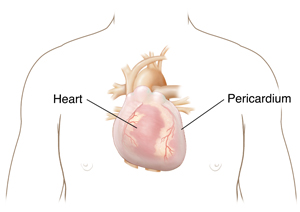Having Pericardiectomy
Pericardiectomy is a surgery to remove part or all of the sac around the heart (pericardium). This lets the heart move more freely.

What to tell your healthcare provider
Tell your healthcare provider about all the medicines you take. This includes over-the-counter medicines, such as ibuprofen. It also includes vitamins, herbs, and other supplements, and illegal drugs. And tell your healthcare provider if you:
-
Have had any recent changes in your health, such as an infection or fever
-
Are sensitive or allergic to any medicines, latex, tape, or anesthesia (local and general)
-
Are pregnant or think you may be pregnant
Tests before your surgery
Before your surgery, you may need tests, such as:
-
Chest X-ray
-
Electrocardiogram (ECG), to check the heart rhythm
-
Blood tests, to look at your general health
-
Echocardiogram to view your heart’s anatomy and blood flow through the heart
-
CT or MRI if the healthcare provider needs more information about your heart
-
Heart catheterization to better look at the coronary blood vessels
Getting ready for your surgery
Talk with your healthcare provider how to get ready for your surgery. You may need to stop taking some medicines before the surgery, such as blood thinners and aspirin.
Also, make sure to do the following:
-
Ask a caretaker to take you home from the hospital. You can't drive yourself.
-
Follow any directions from your healthcare provider about not eating or drinking before your surgery.
-
Follow all other directions from your healthcare provider.
You will be asked to sign a consent form that gives your permission to do the surgery. Read the form carefully. Ask questions if something is not clear.
On the day of surgery
Your procedure will be done by a cardiac surgeon. This is a doctor who specializes in diseases of the heart. They will work with a team of specialized nurses and operating room staff. The surgery can be done in more than 1 way. Ask your healthcare provider about the details of your surgery. The surgery will take several hours. In general, you can expect the following:
-
You will have general anesthesia, medicine that allows you to sleep through the surgery. You won’t feel any pain during the surgery.
-
Hair in the area of the surgery may be removed.
-
The healthcare provider team will watch your vital signs, like your heart rate and blood pressure, during the surgery.
-
Different types of procedures may be done. The surgeon may make a vertical incision along the breastbone. This incision will be several inches long. To reach the heart, the surgeon will separate the breastbone.
-
Or the surgeon may make an incision between the ribs to reach the pericardium.
-
Or the surgeon will make several smaller incisions on the side of the chest. A small camera and tools are inserted through these small incisions to do the surgery.
-
The surgeon removes some or all of the pericardium.
-
The surgeon may make other repairs to the heart if needed.
-
They close all incisions using stitches, staples, or both. They put dressings on the incisions.
After your surgery
After surgery, you will be taken to a recovery room or to the intensive care unit. Nurses will check your breathing, heart rate, and blood pressure. You may have a tube draining fluid from your chest. The drained fluid may be sent to a lab for analysis. You may stay in the hospital for a few days.
You may have some pain at the incision sites after surgery. You can take pain medicines to help relieve it. Only take pain medicine approved by your healthcare provider.
You might have some fluid leaking from your incision. This is normal. Let your healthcare provider know right away if you see an increase in redness, swelling, or fluid from your incision.
Your original heart symptoms may go away quickly after your surgery.
You can go back to your normal food as soon as you feel able. When you go home, you should be able to resume normal activities. Stay away from vigorous exercise until your healthcare provider says you are ready. Don’t lift anything heavy until your provider says it’s OK.
Follow-up care
Follow up with your healthcare provider, or as advised. You will probably have your stitches or staples removed in 7 to 10 days. Make sure you keep all of your follow-up appointments. Follow all the directions your healthcare provider gives you for medicines, exercise, diet, and wound care.
When to call your healthcare provider
Call your healthcare provider right away if any of the following occur:
-
Fever of 100.4°F (38°C) or higher , or as advised by your provider
-
Increase in pain, redness, bleeding, or fluid leaking from the incision
-
Chest pain
-
Other symptoms as advised